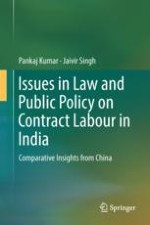2018 | OriginalPaper | Buchkapitel
2. Contract Labour in India: In Law and Public Policy
With Comparative Insights from China
verfasst von : Pankaj Kumar, Jaivir Singh
Erschienen in: Issues in Law and Public Policy on Contract Labour in India
Verlag: Springer Singapore
Aktivieren Sie unsere intelligente Suche, um passende Fachinhalte oder Patente zu finden.
Wählen Sie Textabschnitte aus um mit Künstlicher Intelligenz passenden Patente zu finden. powered by
Markieren Sie Textabschnitte, um KI-gestützt weitere passende Inhalte zu finden. powered by
